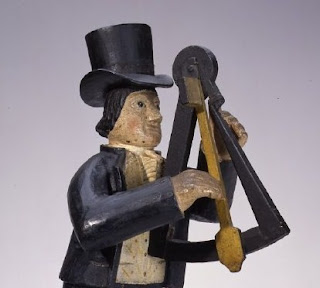While wandering through the show, I kept an eye out for pieces that had certain similaities with ones in the Fenimore Art Museum collection. Here's a good one.
This life-size carved wooden figure depicted a mariner holding a sextant. It is beautifully carved, probably in a large ship carver's shop. At first glance i would have thought it to be American, but according to the label it is English. The piece is attributed to a carver named Thomas Hall Tweedy, who reportedly carved it for a natical instrument maker's shop (the dealer even gave the name of the shop: John Cail!) in Newcastle on Tyne.
This figure undoubtedly sat outside the shop on the sidewalk, like a cigar store figure. But it reminded me so much of a little figure in our collection I just had to photograph it and share it here. Our figure is even mentioned in the dealer's label for the large piece.
Our little mariner is only about 25 inches tall, but it depicts the mariner holding the sextant in the same manner as the large figure. Our is, of course, much more primitive than the large one. But very appealing for those who have an eye for folk art. Our piece was found in New Bedford, Massachusetts, and is thought to have come from a nautical instrument maker's shop in that important coastal city. The small figures would generally be displayed either on countertops or, as I have seen in one period photo, outdoors on a cantilevered mount above the shop doorway.
However separated by thousands of miles of ocean, these two pieces remind us of the seafaring culture that binds the hemispheres. This notion has gained such credibility in recent years that historians speak less and less of American or European history and instead study Atlantic history. Or, as the Mystic Seaport Museum in Mystic, Connecticut, is fond of saying: the sea connects us all.
















No comments:
Post a Comment